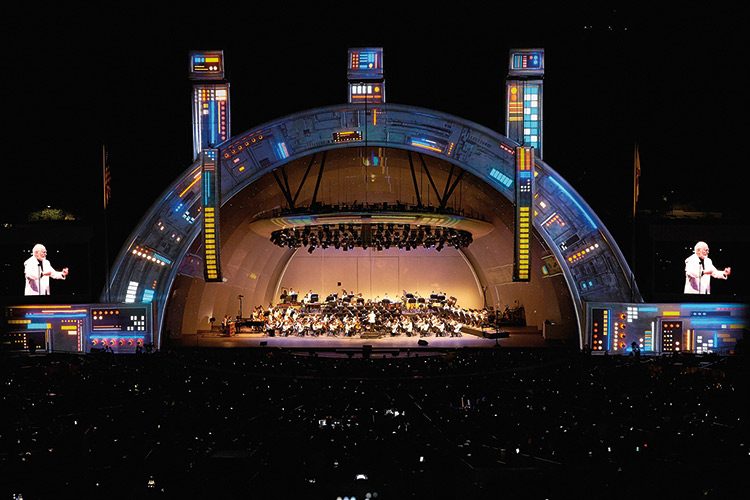Illuminating the L.A. Philharmonic’s centennial
Music lover Greg Russell ’91 can pinpoint a few monumental moments throughout his career as a visual content creator. Among them: working with Neil Peart, drummer of the band Rush, to create an elaborate drum riser and set, then going on tour with him; and designing a visual show for a concert by psychedelic Aussie rock band Tame Impala in New York City. Yet a third epic experience took place last September, when Russell and his company, Xite Labs, transformed the iconic Hollywood Bowl in Los Angeles. They used projection and advanced programming technology to execute an unforgettable night of visual effects in celebration of the L.A. Philharmonic’s 100th anniversary.
Of all the shows Russell and partner Vello Virkhaus have done, this one required the most ingenuity. “It had the most technology, multiple types of software tied together, a lot of creative visuals to dream up, a big team, and a lot of pressure,” Russell says.
Xite Labs was selected from a pool of designers reviewed by the L.A. Philharmonic management through several rounds of presentations, which included illustrated concept boards. Demonstrating how, exactly, they’d sync the conductor’s movements with streaks of projected light around the Bowl (known as motion-reactive visuals) via an interactive camera tracking system no doubt helped them land the job.
In preparation for the show, Russell and Virkhaus led creative direction for the Xite Labs team as they programmed computers to sync audio tracks from each section in the orchestra — woodwinds, brass, high strings, and others — with visual designs. Essentially, when the orchestra would hit certain notes or volumes, the audience would experience different projected visual effects. While the technology itself isn’t particularly unique, Russell notes, it’s what they did with it that set them apart. “It’s like you can put a paint brush in someone’s hands, and they can paint something. But as artists, we can program it at a higher level and put it with a design that makes it more artful,” he says.
One of the biggest challenges was that they didn’t get to test the program live with the orchestra — or any of the other performers, including pop singer Katy Perry and pianist Herbie Hancock — ahead of time. “We joked that the show was our rehearsal,” Russell says. The show went off without a hitch, though, thanks to heavy preparation and a dash of Hollywood magic. Russell even put his own musical talent to work, playing a programmed MIDI keyboard along with Hancock on the song “Rockit” to activate parts of the Bowl as he hit the notes.
Playing in several bands during his time at Colgate, where he earned dual degrees in music and neuroscience, Russell says the campus is where his creative side started to blossom — and eventually led to his career in visual arts. “I don’t think doing well in creative arts requires a background in arts as much as a background in creative thinking,” he says. “The ability to think creatively and act on those ideas with confidence — that’s what I walked away with from Colgate.”

